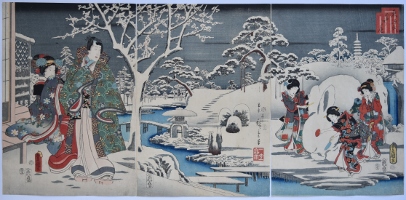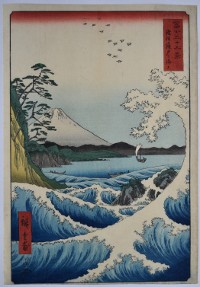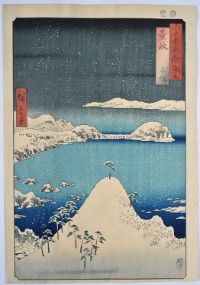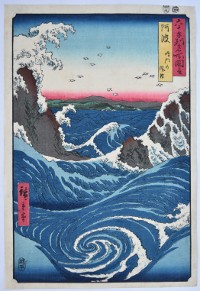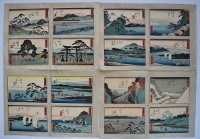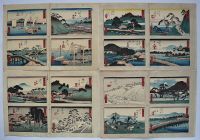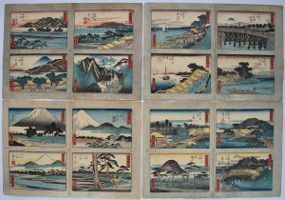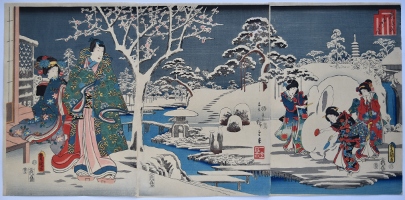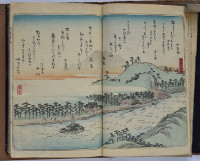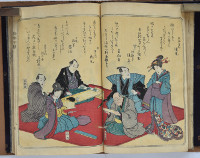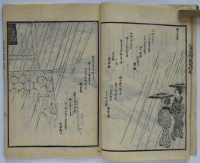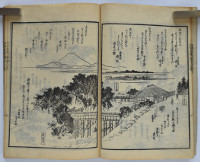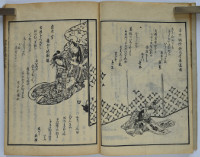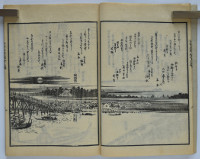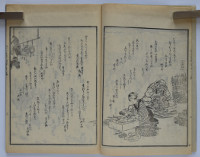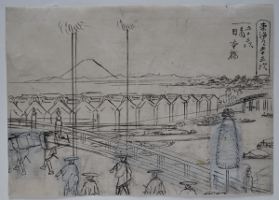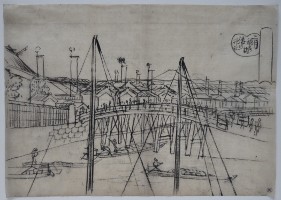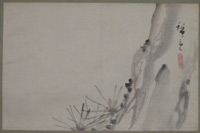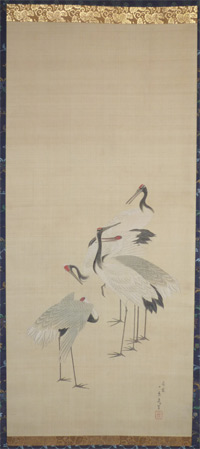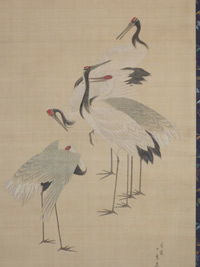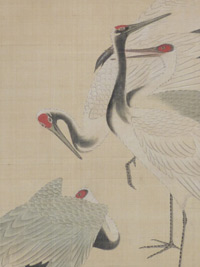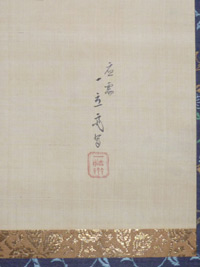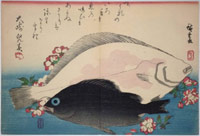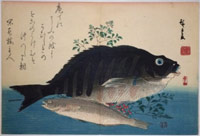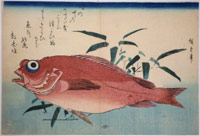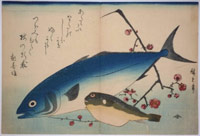Utagawa HIROSHIGE (1797-1858) and Utagawa KUNISADA (1786-1865)
Click here to view image full size.
A triptych showing Mitsuuji, the romantic hero of the Inaka Genji (“A Rustic Genji”) accompanied by a beauty looking out across a snow-covered garden to where a group of girls are building a giant snow rabbit. Hiroshige and Kunisada collaborated on a number of these Genji triptychs in the 1850s and this is one of the most charming. Published by Moriya Jihei of Kinshodo, 12/1854 (and therefore probably in anticipation of the following year, which was a Year of the Rabbit).
Fine impression. The early state with gradation behind the rabbit and bokashi on stream and in the sky. Fine colour. Fine condition. Signed Toyokuni ga on two outside panels and Yuki no kei oju, “Snow landscape by request” Hiroshige hitsu.
Status: Sold
Utagawa HIROSHIGE (1797-1858)
Click here to view image full size.
Suruga Satta no kaijo, “The Sea at Satta, Suruga Province” from the set Fuji sanjurokkei, “The Thirty-Six Views of Fuji.” The series published by Tsutaya Kichizo, 1858. Shows the coast of Oyashirazu at Satta on the west side of Suruga Bay with a large wave about to break on the coast. The spume from the wave is supposed to turn into chidori and they can be seen here flying away. This area is on the Tokaido Road between Edo and Kyoto and, previous to 1655, travellers had to circumvent the cliffs – some of which are 300-400 metres tall – by way of the base, near the sea. However, in that year, to facilitate the journey a pass was cut in the rock above the cliff. The best design from the set. Early impressions of this set were particularly well printed as a tribute to Hiroshige’s life. Late editions have a signature label printed in yellow instead of red.
Fine impression and colour. Trimmed close at bottom left, otherwise fine condition. Signed Hiroshige ga.
Status: Sold
Utagawa HIROSHIGE (1797-1858)
Click here to view image full size.
A fine snow scene: Iki Shisaku, “Shisaku in Iki Province” from a set of sixty-nine prints plus title page Rokuju yoshu meisho zue, “Famous Places in the Sixty-Odd Provinces.” Published by Koshimuraya Heisuke, 1853-1856 (this being 1856). This far-flung region of Japan at the southern tip of the main group of islands is evocatively captured here.
Superb impression of the very rare first edition with variegated cartouche and bokashi clouds. Fine colour and condition. Signed Hiroshige ga.
Status: Sold
Utagawa HIROSHIGE (1797-1858)
Click here to view image full size.
Awa Naruto no fuha, “Angry Seas at Naruto, Awa” from a set of sixty-nine prints plus title page Rokuju yoshu meisho zue, “Famous Places in the Sixty-Odd Provinces.” Published by Koshimuraya Heisuke, 1853-1856 (this being 1855). The most famous design from the set. This area of sea between the islands of Shikoku and Honshu , where the waters of the Inland Sea and Pacific Ocean meet, is famous for its whirlpools. Hiroshige returned to this theme in a triptych setsu-getsu-ka set where the whirlpools represent “Flower.”
Very good impression, colour and condition. Signed Hiroshige ga.
Status: Sold
Utagawa HIROSHIGE (1797-1858)
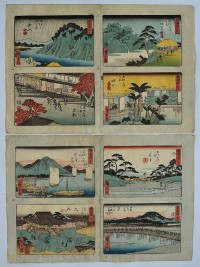
Click here to view image full size.
A complete Tokaido set of 56 prints printed four-to-a-sheet on fourteen sheets, uncut. Each sheet has an indication of where it is to be cut. Published by Aritaya Seiemon, 1845. Extremely rare complete.
Fine impressions and colour. Centre folds and some soil at bottom on some sheets. One sheet restored, but overall in good condition. Each design signed Hiroshige ga.
Status: Sold
Utagawa HIROSHIGE (1797-1858)
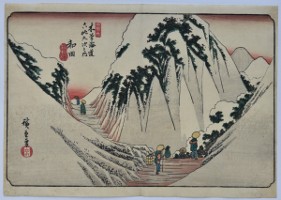
Click here to view image full size.
Shows station Wada in heavy snow from Kisokaido rokujukyutsugi no uchi. The set of seventy prints was started by Eisen and published by Hoeido in 1835, but in 1837 Hiroshige took over and completed the series with the publisher Iseya Rihei (Kinjudo). This high pass (1651 metres) was a difficult part of the journey.
Fine early impression before the break in the key block to the left and beneath the publisher’s gourd seal. Fine colour. Slight centre fold, otherwise very good condition. Signed Hiroshige ga.
Status: Sold
Utagawa HIROSHIGE (1797-1858) and Utagawa KUNISADA (1786-1864)
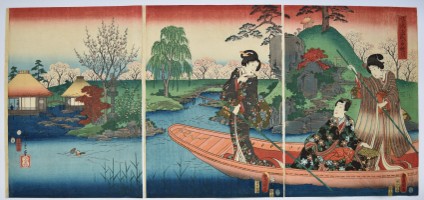
Click here to view image full size.
Prince Genji being poled in a punt on a lake. From a set of such triptychs published by Iseya Kanekichi in 1853. Furyu Genji fune asobi, “Fashionable Genji Enjoying a Pleasure Boat.”
Very fine impression and colour. Slightly trimmed at bottom, otherwise fine condition. Signed Hiroshige ga and Toyokuni ga.
Status: Sold
Utagawa HIROSHIGE (1797-1858) and Utagawa KUNISADA (1786-1864)
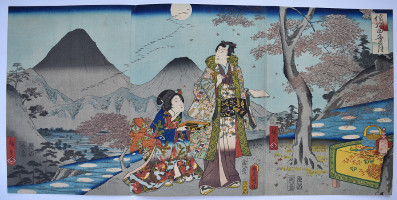
Click here to view image full size.
A triptych Shinshu Sarashina tagoro no tsuki, “The Moon Reflected in the Rice Fields at Sarashina, Shinano Province.” Shows Mitsuuji, the romantic hero of the Inaka Genji (“A Rustic Genji”), admiring the multiple views of the moon reflected in the paddy-fields and about to compose a poem. On the left, Mount Kyodai. This phenomenon was greatly admired and pilgrimages were made to view it. There was a plethora of these Genji parody prints in the 1850s following two popular Kabuki plays and Hiroshige and Kunisada collaborated on a number of such triptychs. Interestingly, this design has a date seal for 3/1861 making it probably the last and based on an existing collaborative hanshita-e. Published by Moriya Jihei. Rare.
Superb impression and colour. Slightly trimmed round; sheets connected and album backing, otherwise very good condition. Signed Hiroshige ga and Toyokuni ga.
Status: Sold
Utagawa HIROSHIGE (1797-1858)
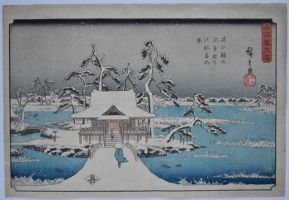
Click here to view image full size.
A snow scene showing the Inokashira Benten Shrine and Inokashira Pond, Inokashira no ike Benzaiten no Yashiro no kei from a set Meisho setsugekka, “Famous Places of Snow, Moon and Flowers.” The pond was originally built to supply water for Edo. This is the first edition published by Zen c. 1842; it was subsequently republished by Maruya Jinpachi and there are further late editions without publisher’s seal, a different seal beneath Hiroshige’s signature and with a recut block giving larger snowflakes.
Fine impression and colour. Minor margin soil, otherwise very good condition. Signed Hiroshige ga.
Status: Sold
Utagawa HIROSHIGE (1797-1858)
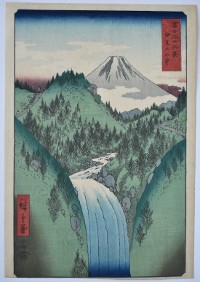
Click here to view image full size.
A view of the beautiful peninsula of Izu, Izu no sanchu, “In the Mountains of Izu Province” from Fuji sanjurokkei, the “Thirty-six Views of Fuji.” The set published by Tsutaya Kichizo, 1858. This area is about 100 km southwest of Tokyo and a popular place to visit.
Very fine impression and colour. Trimmed close bottom left, otherwise fine condition. Signed Hiroshige ga.
Status: Sold
Utagawa HIROSHIGE (1797-1858)
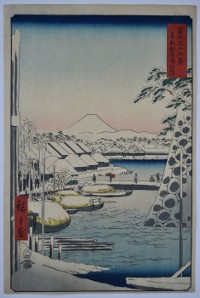
Click here to view image full size.
Sukiya embankment in snow, Toto Sukiya-gashi, from Fuji sanjurokkei, the “Thirty-six Views of Fuji.” The set published by Tsutaya Kichizo, 1858. The rampart on the inner side of the moat of Edo Castle on the right. Figures cross a bridge leading to Sukiya Gate. In the distance the long outer walls of the main residence of the Nabeshima Clan of Saga. Fuji on the horizon.
Very fine impression and colour. A very small repaired wormhole in top right margin, otherwise fine condition. Signed Hiroshige ga.
Status: Sold
Utagawa HIROSHIGE (1797-1858)
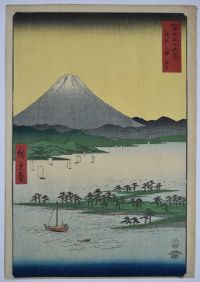
Click here to view image full size.
Suruga Miho no Matsubara, “Miho no Matsubara in Suruga Province” from Fuji sanjurokkei, the “Thirty-six Views of Fuji.” The set published by Tsutaya Kichizo, 1858. Shows the renowned pine trees with a majestic Fuji below a yellow sky. Many of these pines are now hundreds of years old.
Very fine impression, colour and condition. Signed Hiroshige ga.
Status: Sold
Utagawa HIROSHIGE (1797-1858)
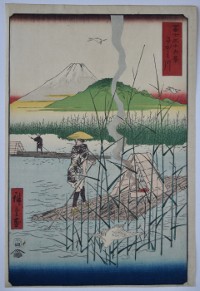
Click here to view image full size.
Men punting rafts on the Sagami River from Fuji sanjurokkei, the “Thirty-six Views of Fuji.” The set published by Tsutaya Kichizo, 1858.This print was included in the background of the famous 1887 portrait of Pere Tanguy by Vincent Van Gogh. The river was sometimes referred to as the Ayu River because of the (then) abundance of sweetwater fish (ayu).
Very fine impression, colour and condition. Signed Hiroshige ga.
Status: Sold
Utagawa HIROSHIGE (1797-1858)
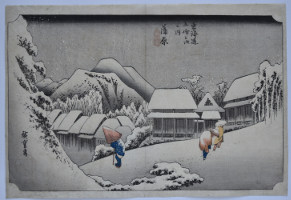
Click here to view image full size.
Kambara, yoru no yuki, “Night Snow at Kambara” from Tokaido gojusan tsugi no uchi, “Fifty-three Stations of the Tokaido Road.” The set published by Hoeido (Takenouchi Magohachi)/Senkakudo, c. 1833-4. One of Hiroshige’s most celebrated designs, discussed and illustrated extensively. This is the very rare first edition: The sky is graded down from the top and the last figure on the right has the uncleared wood evident on the legs. This mistake was soon rectified but in doing so the block cutter made a small break above the knee. Probably the earliest state of the first edition has a blue tint to the gradation on the distant hills: See the Honolulu Academy of Arts impression, 15.927. Kambara owes a lot to Hiroshige’s imagination as it doesn’t resemble any place near there. Also, Kambara has little snow, yet it remains one of Hiroshige’s most iconic images.
Fine impression of the first edition with subtle gradation on the roofs of the houses and elsewhere. Seals a little faded, otherwise very good colour. Slight centre fold, otherwise very good condition. Signed Hiroshige ga.
Status: Sold
Utagawa HIROSHIGE (1797-1858)
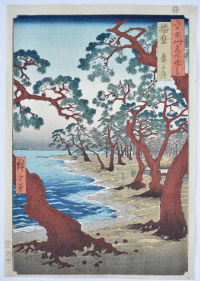
Click here to view image full size.
Harima Maiko no hama, “Maiko Beach Harima Province” from Rokujuyoshu meisho zue, “Famous Views of the Sixty-odd Provinces.” Shows the beach with the famous pine forest stretching down to the water. Published by Koshihei, 1853-6, this being 1853.
Fine impression of the first edition. Slight fading, otherwise very good colour. Fine condition. Signed Hiroshige ga.
Status: Sold
Utagawa HIROSHIGE (1797-1858)
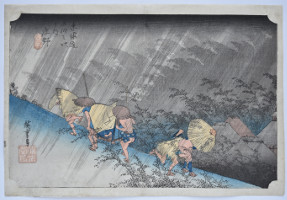
Click here to view image full size.
Shono, haku-u, “Sudden Shower at Shono” from Tokaido gojusan tsugi no uchi, “Fifty-three Stations of the Tokaido Road.” The set published by Hoeido (Takenouchi Magohachi)/Senkakudo, c. 1833-4. Together with Kambara, one of Hiroshige’s most celebrated designs, discussed and illustrated extensively. This is the very rare first edition: The waves of bamboo beautifully graded and strong woodgrain evident on the house roofs bottom right. See Sebastian Izzard, Hiroshige, The Ukiyo-e Society of America, 1983, nos. 17a-e for illustrations and a description of the various states. Although the area had thick groves of bamboo growing along the Suzuka River, there was nowhere that exactly matches the design.
Fine impression of the first edition with subtle gradation. Seals and green a little faded, otherwise very good colour. Slight centre fold, otherwise very good condition. Signed Hiroshige ga.
Status: Sold
Utagawa HIROSHIGE (1797-1858)
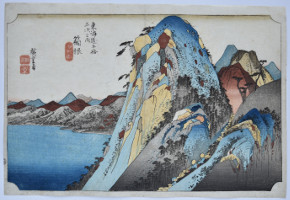
Click here to view image full size.
Hakone, kosui, “Hakone, the Lake” from Tokaido gojusan tsugi no uchi, “Fifty-three Stations of the Tokaido Road.” The set published by Hoeido (Takenouchi Magohachi)/Senkakudo, c. 1833-4. A line of travellers – presumably the deputation of the Edo Shogunate going to Kyoto – making its way down a precipitous path on the right in this mountainous region. This is the very rare first edition: An extremely difficult design to find in early impression as the jigsaw of colours on the mountains need to be perfectly keyed to work.
Fine impression. The red a little faded, otherwise very good colour. Slight centre fold, otherwise very good condition. Signed Hiroshige ga.
Status: Sold
Utagawa HIROSHIGE (1797-1858)
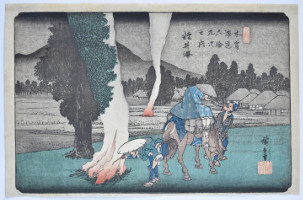
Click here to view image full size.
Station Karuizawa from Kisokaido rokujukyo tsugi no uchi, the “Sixty-nine Stations of the Kiso Kaido.” A night scene after the autumn harvest and the stubble is being burned. In the background the village and Mt Asama in the distance. A traveller stops to get his pipe lit by another traveller illuminated by the light cast from his lantern. Another traveller stoops to light his pipe from one of the bonfires. Published by Hoeido (Takenouchi Magohachi)/Kinjudo (Iseya Rihei), c. 1838. The lantern is inscribed Iseri (for Iseya Rihei) and their mon is partially seen on the saddlecloth of the horse. On later editions this seal was removed. The first edition of this design has a Takenouchi seal to the left of the inscription top centre.
Fine impression. Very good colour and condition. Signed Hiroshige ga.
Status: Sold
Utagawa HIROSHIGE (1797-1858)
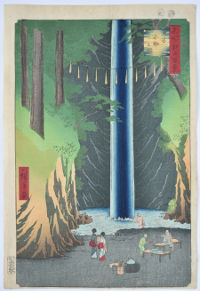
Click here to view image full size.
Oji, Fudo no taki, “Fudo Waterfall, Oji” from Meisho Edo hyakkei, “One Hundred Famous Views of Edo.” The set published by Uoya Eikichi between 1856 and 1859 (this being 1857). Waterfalls were a pleasant way of getting relief from the summer heat. Japan has many hundreds of waterfalls but a considerable number are in remote areas. The government has compiled a list of 100. This is the rare first edition with strong wood-grain and mica applied to the waterfall. Provenance: Purchased from me in 1989.
Very fine impression. Fine colour and condition. Signed Hiroshige ga.
Status: Sold
Utagawa HIROSHIGE (1797-1858)
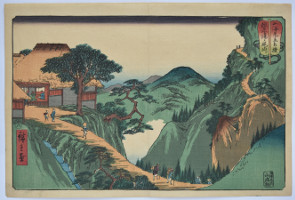
Click here to view image full size.
Echizen Yunoo toge, “Yunoo Pass in Echizen Province” from a set of twenty prints Sankai mitate zumo, “Wrestling Matches Between Mountains and Sea.” Ten prints showing mountain scenes and ten sea scenes (actually harbours). Published by Yamadaya Shojiro, 1858. The title is in a wrestling umpire’s fan. This is the first edition with variegated colour in this fan. The second edition has the fan printed in red only (see BM impression, 1915, 0823,0.152.7).
Fine impression and colour. Slight centre fold, otherwise fine condition. Signed Hiroshige ga.
Status: Sold
Utagawa HIROSHIGE (1797-1858)
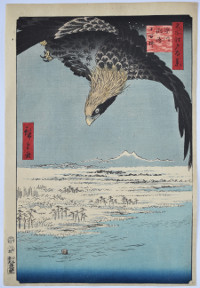
Click here to view image full size.
Fukagawa, Suzaki, juman-tsubo, “The One Hundred Thousand Tsubo Plain, Suzaki, Fukagawa” from Meisho Edo hyakkei, “One Hundred Famous Views of Edo.” The set published by Uoya Eikichi between 1856 and 1859 (this being 1857). An eagle hovers over the snowy coastal plain, Mt Tsukuba and the Chiba mountains in the distance.
Very good impression, colour and condition. Signed Hiroshige ga.
Status: Sold
Utagawa HIROSHIGE (1797-1858)
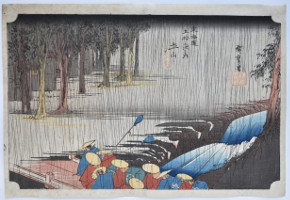
Click here to view image full size.
Tsuchiyama, haru no ame, “Tsuchiyama, Spring Rain.” Number 49 from the famous Tokaido gojusan tsugi no uchi, “The Fifty-three Stations of the Tokaido.” Published by Hoeido, c. 1833-4. Hiroshige travelled the length of the Tokaido as part of an official delegation in 1832 making sketches along the way. On his return he started work on the set eventually producing 55 prints. The first of the designs were published jointly by Hoeido and Senkakudo, but then Hoeido took over the production. Shows a daimyo’s cortege crossing the Tamura River. Tsuchiyama flourished because of its location at the entrance to the Suzuka Pass. However, in Meiji times, the town was bypassed by the railway because of the steep gradients here. This is the rare first edition.
Fine impression. Slight fading of seals, slight centre fold and minimal soil to left edge, otherwise very good condition. Signed Hiroshige ga.
Status: Sold
Utagawa HIROSHIGE (1797-1858)
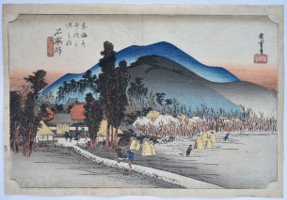
Click here to view image full size.
Ishiyakushi, number 44 from the Tokaido showing figures entering the village with others working in the fields. Ishiyakushi-ji Temple was seen on entering the village. From the famous Tokaido gojusan tsugi no uchi, “The Fifty-three Stations of the Tokaido.” Published by Hoeido, c. 1833-4. Hiroshige travelled the length of the Tokaido as part of an official delegation in 1832 making sketches along the way. On his return he started work on the set eventually producing 55 prints. The first of the designs were published jointly by Hoeido and Senkakudo, but then Hoeido took over the production. This is the rare first edition.
Fine impression. Slight fading of seals, slight centre fold and minimal soil to left edge, otherwise very good condition. Signed Hiroshige ga.
Status: Sold
Utagawa HIROSHIGE (1797-1858)
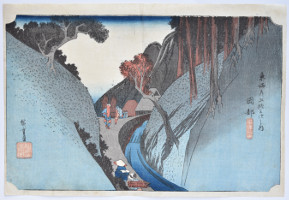
Click here to view image full size.
Okabe, Utsu no yama, “Okabe, Utsu Mountain.” Number 21 from the famous Tokaido gojusan tsugi no uchi, “The Fifty-three Stations of the Tokaido.” Published by Hoeido, c. 1833-4. Hiroshige travelled the length of the Tokaido as part of an official delegation in 1832 making sketches along the way. On his return he started work on the set eventually producing 55 prints. The first of the designs were published jointly by Hoeido and Senkakudo, but then Hoeido took over the production. Utsunoya Pass is just before Okabe. The pass is the scene of a Kabuki play by Mokuami Kawatake (1816-1893) where Jubei Itamiya kills and robs the blind Bun’ya. This is the rare first edition.
Fine impression. Slight fading of seals, slight centre fold and minimal soil to left edge, otherwise very good condition. Signed Hiroshige ga.
Status: Sold
Utagawa HIROSHIGE (1797-1858)
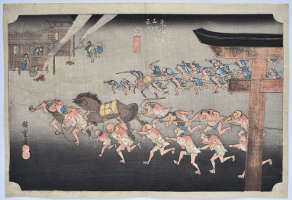
Click here to view image full size.
Miya, Atsuta shinji, “Miya, Festival of the Atsuta Shrine.” Number 41 from the famous Tokaido gojusan tsugi no uchi, “The Fifty-three Stations of the Tokaido.” Published by Hoeido, c. 1833-4. Hiroshige travelled the length of the Tokaido as part of an official delegation in 1832 making sketches along the way. On his return he started work on the set eventually producing 55 prints. The first of the designs were published jointly by Hoeido and Senkakudo, but then Hoeido took over the production. Miya was the largest station on the Tokaido. There were many inns catering for the pilgrims going to Ise and daimyo travelling to Edo. Shows the horse-driving festival held at the Shinto Atsuta Shrine, the Hama Gateway to the right. This is the rare first edition.
Fine impression. Slight fading of seals, slight centre fold and minimal soil to left edge, otherwise very good condition. Signed Hiroshige ga.
Status: Sold
Utagawa HIROSHIGE (1797-1858)
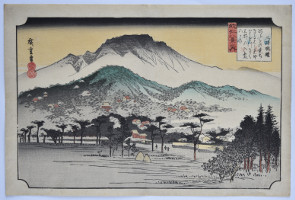
Click here to view image full size.
Mii no bansho, “Evening Bell at Miidera Temple” from an early set Omi hakkei no uchi, “Eight Views in Omi Province.” Shows the temple hidden amongst hills on the southern side of Lake Biwa. Miidera is the common name for the Onjoji, a temple of the Tendai sect, founded in 858. Published by Hoeido and Eikyudo in c. 1834-5. The “Eight Views” theme was derived (as so much else in Japanese art) from China and based on the Eight Views of Xiaoxiang paintings of the 11th century. The subject was transposed to Omi and then taken up by such artists as Harunobu , and later Hiroshige. It was also often playfully alluded to in sets of eight prints in mitate-e style.
Fine early impression and colour. Imperceptible centre fold, otherwise fine condition. Signed Hiroshige ga.
Status: Sold
Utagawa HIROSHIGE II (1829-1869)
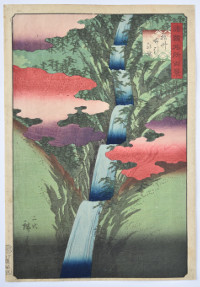
Click here to view image full size.
Sesshu Nunobiki no taki, “The Nunobiki Waterfall in Settsu Province,” from a set Shokoku meisho hyakkei, “One Hundred Famous Views in the Various Provinces.” The set published by Uoya Eikichi between 1859 and 1861 (this being 1859). He was the pupil of Hiroshige, given the name Shigenobu. After Hiroshige’s death he married his adopted daughter and became Hiroshige II. The couple were divorced in 1865. She went on to marry another pupil of her father’s – Shigemasa, who became Hiroshige III.
Superb impression and colour with extensive mica and woodgrain. Fine condition. Signed “The second” Hiroshige ga.
Status: Sold
Utagawa HIROSHIGE (1797-1858) and Utagawa KUNISADA (1786-1865)
Click here to view image full size.
A triptych showing Mitsuuji, the romantic hero of the Inaka Genji (“A Rustic Genji”) accompanied by a beauty looking out across a snow-covered garden where a group of girls are building a giant snow rabbit. Hiroshige and Kunisada collaborated on a number of these Genji triptychs in the 1850s and this is one of the most charming. Published by Moriya Jihei of Kinshodo, 12/1854 (and therefore probably in anticipation of the following year, which was a Year of the Rabbit).
Very good impression, colour and condition. Signed Toyokuni ga and Yuki no kei oju, “Snow landscape by request” Hiroshige hitsu.
Status: Sold
Utagawa HIROSHIGE (1797-1858) and Utagawa YOSHITORA (active c. 1850-1880)
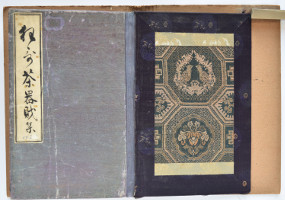
Click here to view image full size.
One volume complete Kyoka chakizai gazoshu, “Tea Ceremony Utensils, a Kyoka Collection.” Published Ansei 2, 1855 by Seiryuteizo. Inside front cover artists given as Ichiryusai Hiroshige and Ichimosai Yoshitora. Three pages preface; three pages decorative labels; four pages landscapes by Hiroshige (including the Uji River – a prime tea growing area); twelve pages of portraits by Yoshitora; twenty-one pages kyoka poems. Original covers with a hand inscribed title slip. Ex collection Edmond de Goncourt with his brocade binding and imitation wood slipcase. In very good condition.
Status: Sold
Utagawa HIROSHIGE (1797-1858)
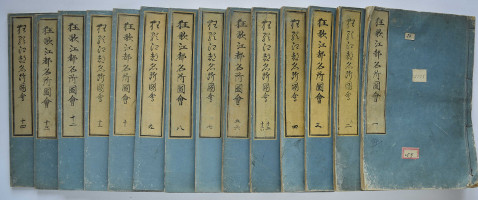
Click here to view image full size.
A complete set of Kyoka Edo meisho zue, “Collection of Pictures of the Famous Places of Edo in Kyoka.” Fourteen volumes (sixteen books) dated Ansei 3, 1856. Artist: Ryusai Hiroshige ga, with volumes fifteen and sixteen being by Hiroshige II. Compiler of poems: Tenmei Rojin. Publisher not given. Book 1: 25 sheets, 11 illustrations. Book 2: 24 sheets, 10 illustrations. Book 3: 23 sheets, 10 illustrations. Book 4: 19 sheets, 9 illustrations. Books 5-6: 34 sheets, 15 illustrations. Book 7: 22 sheets, 9 illustrations. Book 8: 21 sheets, 9 illustratins. Book 9: 22 sheets, 9 illustrations. Book 10: 21 sheets, 8 illustrations. Book 11: 14 sheets, 6 illustrations. Book 12: 18 sheets, 7 illustrations. Book 13: 16 sheets, 6 illustrations. Book 14: 16 sheets, 8 illustrations. Books 15-16: 23 sheets, 9 illustrations. The monochrome illustrations show the popular life of Edo as well as the views. Original covers and title slips.
In very good condition. Rare complete.
Status: Sold
Utagawa HIROSHIGE (1797-1858)
Click here to view image full size.
An important original drawing by Hiroshige being an hanshita-e (preparatory sketch) for an unpublished series Toto meisho gojusan tsugi, “Fifty-Three Views of Edo.” Shows Nihonbashi with a daimyo’s cortege crossing. Warehouses in the background and a distant Fuji.
Probably executed c. early 1850s. Sumi on thin paper, 9.5 x 13.5 in; 24 x 34 cms. Extensive pentimenti. Sold “as is” with imperfections but in good condition. Provenance: Ex Huguette Beres collection, sold Sothebys, Paris, 27/11/2002, lot 177.
Status: Sold
Utagawa HIROSHIGE (1797-1858)
Click here to view image full size.
An important original drawing by Hiroshige being an hanshita-e (preparatory sketch) for an unpublished series Toto Fujimi junigatsu, “Mount Fuji Viewed from Edo in the Twelve Months.” This is February showing the Inari Bridge and the Minato Temple; boats in the foreground and Fuji in the distance.
Probably drawn c. early 1850s. Sumi on thin paper. Sold “as is” with imperfections but in good condition. Provenance: Ex Huguette Beres collection, sold Sothebys, Paris, 27/11/2002, lot 179.
Status: Sold
Utagawa HIROSHIGE (1797-1858)
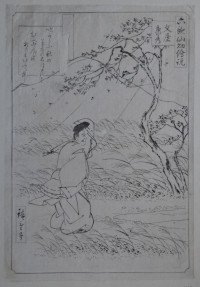
Click here to view image full size.
An original oban (14 x 9.5 in; 35.5 x 24 cms) hanshita-e drawing, sumi on thin paper, for an unpublished set Rokkasen kiri etoki, “Picture Storytelling of Climatic Scenes of the Six Immortal Poets.” In this case the poet Fun’ya no Yasuhide and depicts his most famous poem, no. 22 in the Hyakunin Isshu, which describes the autumn gales bending the trees and grasses. Shows the poet caught in a gale. In fact this is the same subject as a published design in a chu-tanzaku set by Hiroshige published by Shogendo in c 1835-39 (see MFA, Boston, acc. no. 21.7035): Possibly the publisher changed his mind about the format to use. Signed Hiroshige ga. Sold “as is” but in good condition.
Status: Sold
Utagawa HIROSHIGE (1797-1858)
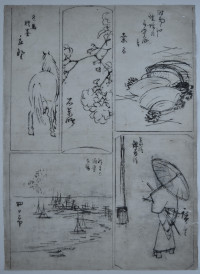
Click here to view image full size.
An original harimaze-e drawing (two or more images on a single page originally intended to be cut apart). Sumi on paper. Intended for a set of such prints of the complete Tokaido. This sheet shows five stations: Shono (horse); Ishiyakushi (cherry blossom); Kuwana (oysters and cockles); Asakusa (the tori of a temple and visitor); Yokkaichi (boats in the bay). Provenance: Ex H. Beres collection, sold Sothebys, Paris, 25/11/2003, lot 168. Minor faults, but all congruent with an original drawing that has survived. Signed Hiroshige bottom right.
Status: Sold
Utagawa HIROSHIGE (1797-1858)
Click here to view image full size.
A small drawing taken from an album of an old pine tree. Sumi and light colour on paper. Image size, 23.25 x 11 inches; 59 x 28 cms. Mounted as a painting. Very good condition. Signed Hiroshige.
Status: Sold
Utagawa HIROSHIGE (1797-1858)
Click here to view image full size.
A fine and rare painting: Gunkaku zu, “A Flock of Cranes.” Hiroshige designed many fine kachoga during the 1830s through to the 1850s but there exist few paintings. This was a commissioned work from Hiroshige. The tancho ( “red crest” ) Japanese Crane, Grus japonensis, is the second rarest crane in the world, migrating to East Asia in the fall to spend the winter. There is also a resident flock in Hokkaido. Much loved by the Japanese, the crane was a symbol of luck, longevity and fidelity. Full colour on silk, image size 34.5 x 15.75 inches; 88 x 40 cms. In perfect condition with a futo-maki ( thick wooden roll to preserve the painting from damage ). New box. Signed Ojyu ( “commissioned” work ) Ichiryusai hitsu. ( A rare form of the signature used c. Tenpo 10 to 11 [ around 1839 – 40 ]. ) The Ichiryusai seal is also a rare form used around mid Tenpo period.
Status: Sold
Utagawa HIROSHIGE (1787-1858)
Click here to view image full size.
Hirame, olive halibut ( Paralichthys olivaceus ) and mebaru, black rock-fish ( Sebastes schlegeli ). Together with cherry blossom. Poem by Osaki Koharu. From the second series of nine fish prints published c 1840 – 42 by Yamasho ( Yamadoya Shobei ). Ex collection Felix Bracquemond ( 1833 – 1914 ). Japonisme in France usually starts with Bracquemond who was a graphic artist and designer and also worked with ceramics. He discovered Hokusai’s Manga in 1856 and used it as source material. He produced a number of etchings, often of birds and some with fish, obviously partly inspired by Japanese prints, including Hiroshige’s prints. So, it’s reasonable to suppose these were the actual prints he used as inspiration. Bracquemond’s initial: “B” accompanied the prints.
Very good impression, colour and condition. Centre fold as per usual. Signed Hiroshige ga.
Status: Sold
Utagawa HIROSHIGE (1787-1858)
Click here to view image full size.
Shimadai, a grouper ( probably Chilodactylus zonatus ) and ainame, greenling ( Hexagrammus otakii ). Together with red-berried nanten. Poem by Kanshunro Nushibito. From the second series of nine fish prints published c 1840 – 42 by Yamasho ( Yamadoya Shobei ). Ex collection Felix Bracquemond ( 1833 – 1914 ). Japonisme in France usually starts with Bracquemond who was a graphic artist and designer and also worked with ceramics. He discovered Hokusai’s Manga in 1856 and used it as source material. He produced a number of etchings, often of birds and some with fish, obviously partly inspired by Japanese prints, including Hiroshige’s prints. So, it’s reasonable to suppose these were the actual prints he used as inspiration. Bracquemond’s initial: “B” accompanied the prints.
Very good impression, colour and condition. Centre fold as per usual. Signed Hiroshige ga.
Status: Sold
Utagawa HIROSHIGE (1787-1858)
Click here to view image full size.
Akodai, the rock-fish. ( Sebastes matsubarae ). Known as the medetai, good-luck fish. Together with bamboo grass. Poem by Suzugaki. From the second series of nine fish prints published c 1840 – 42 by Yamasho ( Yamadoya Shobei ). Ex collection Felix Bracquemond ( 1833 – 1914 ). Japonisme in France usually starts with Bracquemond who was a graphic artist and designer and also worked with ceramics. He discovered Hokusai’s Manga in 1856 and used it as source material. He produced a number of etchings, often of birds and some with fish, obviously partly inspired by Japanese prints, including Hiroshige’s prints. So, it’s reasonable to suppose these were the actual prints he used as inspiration. Bracquemond’s initial: “B” accompanied the prints.
Very good impression, colour and condition. Centre fold as per usual. Signed Hiroshige hitsu.
Status: Sold
Utagawa HIROSHIGE (1787-1858)
Click here to view image full size.
Inada, yellowtail or amberjack ( Seriola quinqueradiata ) and fugu, blowfish or puffer ( Fugu pardalis ). Together with plum blossom. Poem by Suzugaki. From the second series of nine fish prints published c 1840 – 42 by Yamasho ( Yamadoya Shobei ). Ex collection Felix Bracquemond ( 1833 – 1914 ). Japonisme in France usually starts with Bracquemond who was a graphic artist and designer and also worked with ceramics. He discovered Hokusai’s Manga in 1856 and used it as source material. He produced a number of etchings, often of birds and some with fish, obviously partly inspired by Japanese prints, including Hiroshige’s prints. So, it’s reasonable to suppose these were the actual prints he used as inspiration. Bracquemond’s initial: “B” accompanied the prints.
Very good impression, colour and condition. Centre fold as per usual. Signed Hiroshige hitsu.
Status: Sold
